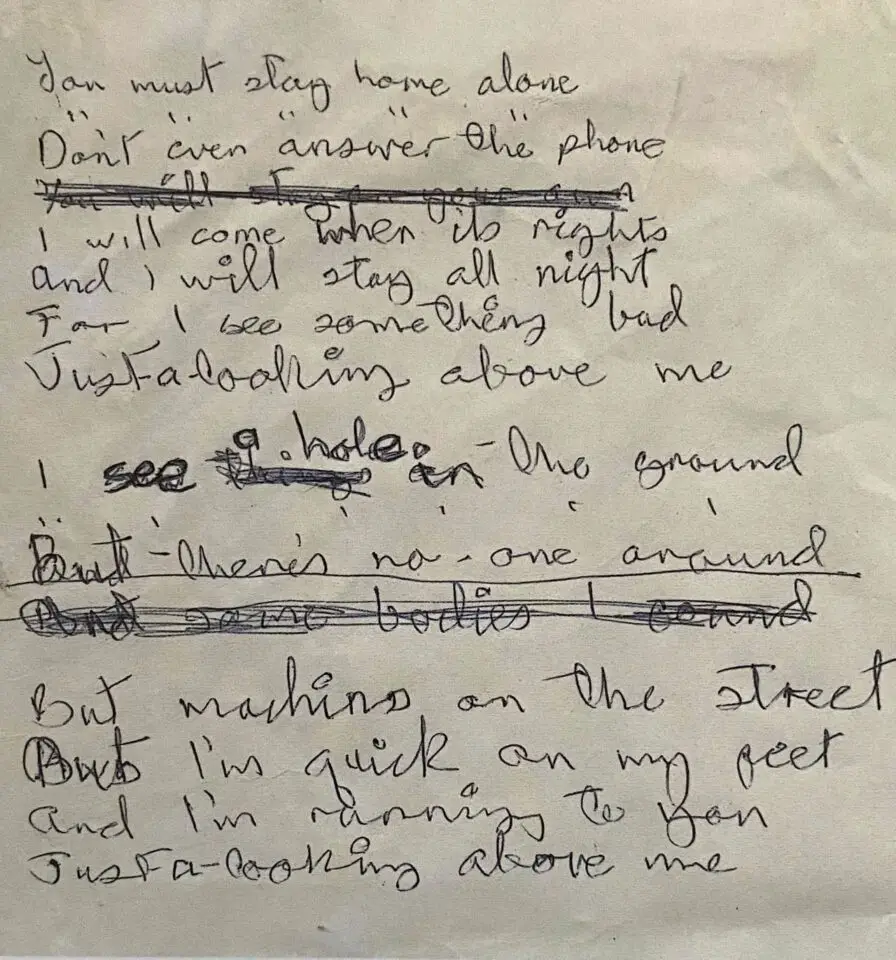 Written by: David Bowie
Written by: David Bowie
Recorded: 1969/1970; July, October 2000
Producer: Mark Plati (2000)
Released: 15 November 2019
Available on:
Conversation Piece
Toy
Personnel
Demo:
David Bowie, George Underwood: vocals, guitar
2000:
David Bowie: vocals, keyboards
Earl Slick: guitar
Mark Plati: slide guitar, keyboards
Mike Garson: piano, keyboards
Lisa Germano: recorder
Gail Ann Dorsey: bass guitar
Sterling Campbell: drums
A home demo of ‘Hole In The Ground’ was recorded by David Bowie and George Underwood in 1969 or early 1970, and re-recorded by Bowie in 2000 for the Toy album.
According to Underwood, the song was under consideration for release as a single, with an instrumental version titled ‘Lump On The Hill’ on the b-side, but this never came to pass. The demo was issued in 2019 in the Conversation Piece box set.
‘Hole In The Ground’ was one of several old songs by Bowie to be recorded for the abandoned Toy project. The recording leaked online in 2011, and was officially released in November 2021.
This was the first song we addressed after the break in August 2000. We decided to work at my home studio in the East Village – it was David’s idea, as I hadn’t considered the possibility of doing a session there. It was most definitely not a ‘real’ studio by any stretch – it was a small but sunny studio apartment with a big terrace, which at the time I had been both living in and using as a preproduction room. David loved it – it was a bright yet low key, no pressure environment in the middle of a groovy neighborhood. We ended up working there much more over the next few months. Long after I began to live elsewhere, I kept the space and use it as a studio to this day. After all, if David Bowie likes it…‘Hole’ was the most underdeveloped of the songs. While the band did well with it at Sear, we had to figure out how to make it more interesting as the song itself was pretty simple. David brought over a new keyboard – a Korg Triton – which he used to add a string pad and a couple of effects. Another effort to tart it up involved distorting the drums. After messing about with a few instrument, David had be play slide of all things – which I don’t really play, though my naive/unaccomplished approach was just what he wanted. In a matter of a few hours, ‘Hole’ had a new face.
After I met Lisa Germano and proposed that she work on the record, we had David check out her music. While she had been a violinist for more than a few artists – a short short list would include John Mellencamp, Simple Minds and Neil Finn from Crowded House – that was only the beginning of the story. Lisa was a solo artist on 4AD, and her records were anything but conventional – dense instrumentation that could be sweet and atonakl at the same time (most of it provided by Lisa herself) the subject of which usually probed the darker side of the human psyche. David got her record Geek The Girl and, in the usual fashion, Lisa was soon on a plane. She came with a small arsenal of eclectic instruments – two violins (one standard, one tuned an octave lower than usual), a 1920s Gibson mandolin, a recorder, and an old, tiny tortoise shell blue-green Hohner accordion with a strap so old and tired we had to beg it to stay together (assisted by duct tape) for the duration of a song.
Lisa quickly took to the material and put down all sorts of parts on the songs, while David kept pulling ideas out of the air for her to try. It was great to see how well they got on and how musically in sync they were from the first few minutes together – by that time I knew he could spot a willing and able musical accomplice a mile off, so I just sat back and hit the ‘Record’ button. At one point David picked up her violin and started playing it, telling us John Cale had taught him how.
‘Hole’ was typical of the process – David pulled an odd melody out of the aid for Lisa to play on recorder, something she or I would never have dreamt up; he said something like ‘I love when I do this’ with a mischievous wink, like a kid that’d managed to sneak an extra piece of cake when mom wasn’t looking. He then had her play accordion to the string pads he had done, which created a cool composite sound (if slightly out of tune). Her violin on ‘Let Me Sleep Beside You’, ‘I Dig Everything’ and ‘You’ve Got A Habit’ is the secret sauce that pushes those songs slightly off the rails, and her recorder in ‘Silly Boy Blue’ brings something child-like that slightly offsets the sophisticated string arrangement. These bittersweet elements of fragile, quirky, melancholic or occasionally angsty Americana were not something we’d anticipated, but we fully embraced.
A last fun little detail about ‘Hole’. When we returned to Looking Glass for more recording, we put some of David’s vocal through their Leslie organ speaker. They had a wonderful sounding Leslie – a nice, warm, distortion when you turned it up some. It made David seem like he was singing from Venus. Hey, the song seemed to want it!
Brilliant Adventure (1992-2001) book

